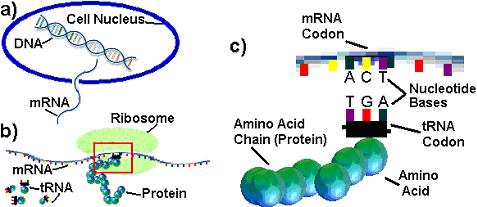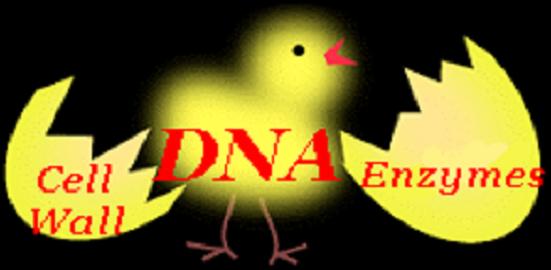Consider the following explanation from evolutionist biologist Frank B. Salisbury from
American Biology Teacher, Sept. 1971, pg. 338:
"Surely our ideas about the origin of life will have to change radically with the passage of time. Not only is the gene itself a problem: think of the system that would have to come into being to produce a living cell! It's nice to talk about replicating DNA molecules arising in a soupy sea, but in modern cells this replication requires the presence of suitable enzymes. Furthermore, DNA by itself accomplishes nothing. Its only reason for existence is the information that it carries and that is used in the production of a protein enzyme. At the moment, the link between DNA and the enzyme is a highly complex one, involving RNA and an enzyme for its synthesis on a DNA template; ribosomes; enayzmes to activate the amino acids; and transfer-RNA molecules. Yet selection only acts upon phenotypes and not upon the genes. At this level, the phenotype is the enzyme itself. How, in the absence of the final enzyme, could selection act upon DNA and all the mechanisms for replicating it? It's as though everything must happen at once: the entire system must come into being as one unit, or it is worthless. There may well be ways out of this dilemma, but I don't see them at the moment."

Figure 1. The transcription - translation process:
In part a, DNA in the cell nucleus is “transcribed” into mRNA, which is then transported out of the nucleus to the ribosome. In part b, free-floating pieces of DNA, called tRNA, bind to the mRNA at the ribosome. All tRNA have amino acids attached to them. When the tRNA binds to the mRNA, the amino acids are linked into a protein. Part c is an expansion of the area in the red box of part b. Each tRNA has a “codon” and each type of codon always carries a particular amino acid. A “codon” is a small piece of DNA with 3 nucleotide bases. In DNA, there are 4 types of nucleotide bases (see Figure 1). An “A” (Adenine) only bonds with a “T” (Thymine) and a “C” (Cytozine) matches only with a “G” (Guanine). Thus, the codon on the tRNA can only match specific codons on the mRNA. This forms the basis of the language in the DNA, allowing the amino acids to be strung together in the sequence specified by the DNA. |
An often undiscussed aspect of complexity is how the tRNA get assigned to the right amino acids. For the DNA language to be translated properly, each tRNA codon must be attached to the correct amino acid. If this crucial step in DNA replication is not functional, then the language of DNA breaks down. Special enzymes called aminoacyl - tRNA synthetases (aaRSs) ensure that the proper amino acid is attached to a tRNA with the correct codon through a chemical reaction called "aminoacylation." Accurate translation requires not only that each tRNA be assigned the correct amino acid, but also that it not be aminoacylated by any of the aaRS molecules for the other 19 amino acids. One biochemistry textbook notes that because all aaRSs catalyze similar reactions upon various similar tRNA molecules, it was thought they "evolved from an common ancestor and should therefore be structurally related." (Voet and Voet pg. 971-975) However, this was not the case as the, "aaRSs form a diverse group of [over 100] enzymes … and there is little sequence similarity among synthetases specific for different amino acids." (Voet and Voet pg. 971-975) Amazingly, these aaRSs themselves are coded for by the DNA: this forms the essence of a chicken-egg problem. The enzymes themselves build help perform the very task which constructs them!

Figure 2. DNA is so vital to the cell, that the origin of DNA presents an example of the infamous “chicken and egg problem:”
Which came first? DNA needs enzymes to replicate, but the enzymes are encoded by DNA. DNA needs protection provided by the cell wall, but the cell wall is also encoded by the DNA. The answer is that none came “first” for all are required in DNA-based life. These fundamental components form an irreducibly complex system in which all components must have been present from the start. This presents a challenge to the step-by-step evolution required by Darwin’s theory.
|
